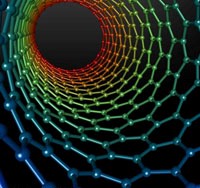Sunlight used to turn CO2, water vapour into natural gas
 London, February 6 : Materials scientists at Pennsylvania State University in University Park have successfully used sunlight to convert carbon dioxide and water vapour into a range of fuels faster than ever before.
London, February 6 : Materials scientists at Pennsylvania State University in University Park have successfully used sunlight to convert carbon dioxide and water vapour into a range of fuels faster than ever before.
Lead researcher Craig Grimes has revealed that his team used hollow titania (titanium dioxide) nanotubes-around 135 nanometres wide and a tenth of a millimetre long-to catalyse the reaction.
Though titania nanoparticles have been used to speed up this process earlier also, Grimes' team were able to generate hydrocarbons around 20 times faster than that achieved in previous studies.
The researchers attribute their success to clever chemistry. They added a little nitrogen to their nanotubes and loaded copper and platinum nanoparticles onto the surfaces.
While titania works best as a catalyst for this reaction in ultraviolet light on its own, Grimes says that adding nitrogen and copper to the mix shifts the preference of the titania tubes to visible light.
And the copper and platinum nanoparticles are thought to speed up the latter stages of the reaction.
The reaction itself also takes place inside the nanotubes, which are hollow and have a large internal surface area thanks to their thin 20-nanometer-thick walls.
During the study, Grimes and his colleagues filled steel tubes with carbon dioxide and water vapour, covered the end of the chambers with a film of their nanotubes, and capped the containers with a quartz window to let light in.
The researchers later set the closed chambers outside on the university campus on sunny days, from July to September 2008, reports Nature magazine.
When light falls on the nanotubes, they release energetic charge carriers, which split the water molecules inside them into two reactive components - hydroxide radicals and hydrogen ions. The hydrogen ions combine to form hydrogen gas.
Although the research team is yet unclear exactly what happens next, they think that the carbon dioxide also splits to form oxygen and carbon monoxide, which then reacts with gaseous hydrogen to form methane and water.
The devices generated roughly 160 microlitres of the hydrocarbons per hour per gram of their titania nanotubes, a rate at least 20 times higher than in previous studies done with ultraviolet light.
Physical chemist Michael Gratzel at the Federal Polytechnic School of Lausanne in Switzerland says that the efficiency of the catalyst is still quite low, but is optimistic that further work can improve it.
An article on this work has been published online in the journal Nano Letters. (ANI)